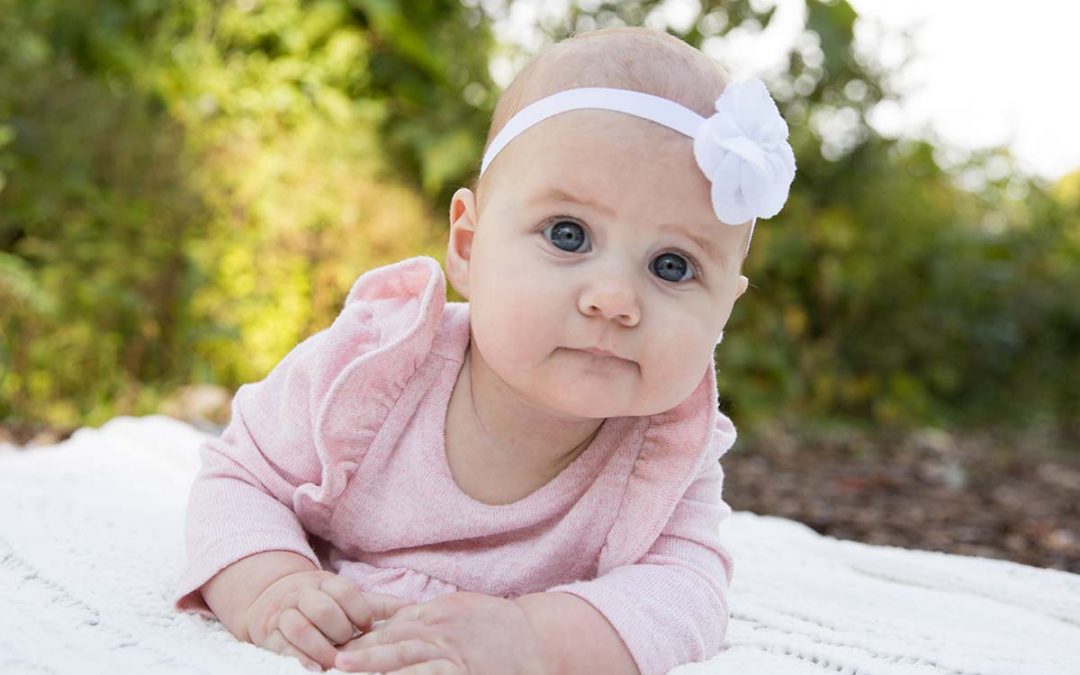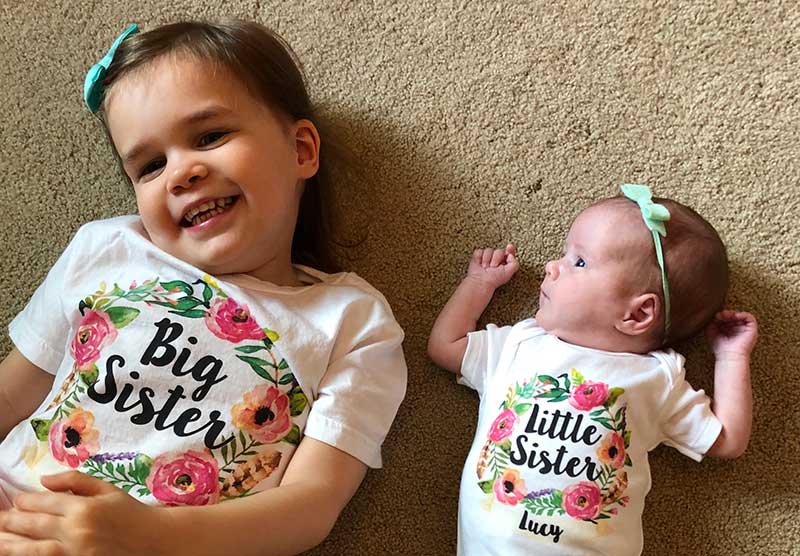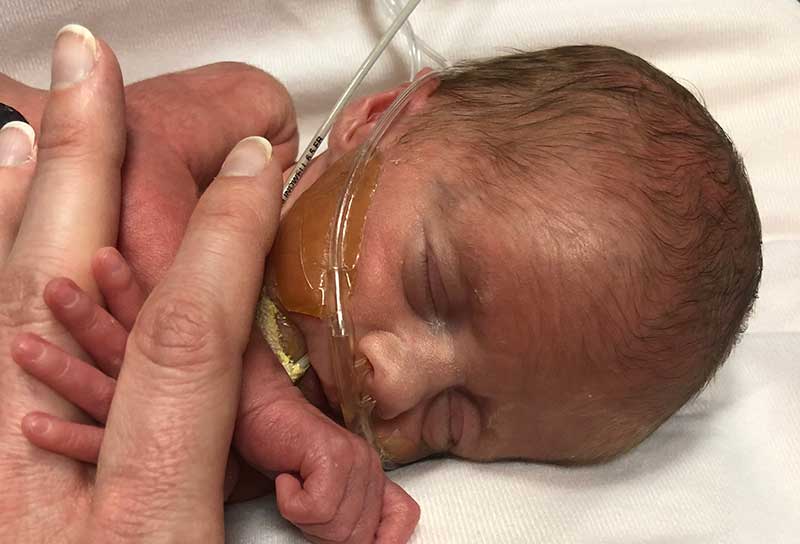Article and photos courtesy of Katherine Stahl, patient’s mom.
Shared with the permission of our partners at Texas Children’s Fetal Center.
Chicago residents Kat and Justin were eager to get a peek at their child’s 20-week ultrasound. They were delighted to see their unborn daughter Lucy via the ultrasound, but were also met with some unexpected news.
“The technician showed us our baby, but also mentioned there was a growth. After a second ultrasound, the maternal-fetal medicine doctors confirmed our baby had sacrococcygeal teratoma,” Kat recalled.
Found more often in girls than boys, sacrococcygeal teratoma (SCT) is a tumor, or growth, that develops from the coccyx (tailbone). It is the most common type of tumor in newborns, occurring in 1 in 35,000 births.
Prenatal SCTs can be internal (growing inside the fetus’ body) or external (growing out of the body). Usually, they are small and benign (non-cancerous) and cause no problems during pregnancy. However, they can grow large – in some instances, larger than the baby.
Lucy’s tumor was Type 3, both internal and external, and much larger than her doctors considered operable. It was also mostly solid, which meant it required a blood supply, causing the heart to work harder to supply blood to both the baby and the tumor. So, the unfortunate best option, it seemed, was to terminate the pregnancy.
Lucy’s tumor volume to fetal weight (TFR) was 0.27. A TFR of greater than 0.12 is typically given a poor prognosis, that the baby will not survive.
“We knew there was no way we were going to terminate. Our girl was worth fighting for and we wanted to do the best we could for her,” Kat said.
Devastated but hopeful, the family began to research children’s hospitals around the country, hoping to find help somewhere.
“We learned they would be unable to perform this type of surgery in our current hospital system, so we found another hospital in the Chicago suburbs, still looking for answers. We learned there are very few hospitals in the country that specialize in working with SCTs and Texas Children’s was one of them,” Kat said.
Thankfully for Kat, she was traveling to Houston to visit family, so she decided to schedule an appointment at the Fetal Center at Texas Children’s Pavilion for Women.
“I didn’t expect to learn anything different, but I asked my doctor to refer me to Texas Children’s anyway. I just wanted another opinion,” Kat recalled.
On Jan. 29, 2019, Kat met with Dr. Timothy Lee, a pediatric surgeon at the Pavilion for Women who gave her what she was searching for – hope.
“I remember he said, ‘We’ve seen bigger tumors and have operated on larger ones.’ I asked him over and over again: Are you sure you can operate on this? He responded, ‘Our philosophy is that every child deserves a chance.’ Although he could not promise a perfect outcome, hearing him say the tumor was operable and that Lucy had a chance was enough for me. Other hospitals did not even give us a sense of hope and now someone was staring at Lucy’s MRI and saying the tumor was operable. I was ready to move my whole family to Houston,” Kat recalled.
The couple agreed to place their trust in these physicians and surgeons; giving Lucy a chance. They packed their bags and moved to Houston nine days later. Kat and her 3-year-old child flew, while Justin followed in a car full of their belongings so they could move into her parents’ house in Sugar Land.
“Once we settled in, the doctors started monitoring her very closely. Working with Dr. Sanz-Cortes, I had an ultrasound twice a week which showed Lucy was growing, but so was her tumor,” Kat recalled.
A common side effect of SCT is polyhydramnios, or elevated amniotic fluid. This would later cause Kat to need to stay inpatient until her delivery and send her into early labor.
“Just before 29 weeks, my amniotic fluid became too high and I was incredibly uncomfortable, because there was so much fluid. I needed an amnioreduction procedure to remove some of the excess fluid, which went well,” Kat said. One liter of amniotic fluid was removed.
Having an amnio reduction can result in contractions because of the change in pressure in the uterus. Kat began experiencing contractions, and although she was not in labor, her team thought it best to keep her in the hospital for close monitoring until it was time to deliver Lucy.
Kat’s amniotic fluid continued to rise, so she underwent another amino reduction procedure at 30 weeks. Again, just over one liter of amniotic fluid was removed.
“On March 9, I underwent another aminoreduction and went into labor that same evening. My doctors hoped to get me to 32-34 weeks, but because the tumor was so large, my body thought there was a full-term baby ready to deliver. Dr. Jimmy Espinoza performed a C-section to deliver Lucy without disturbing the tumor. I was scared,” Kat remembered.
Lucy was delivered at 30 weeks weighing 9 lbs., a heavier size for a preemie her age, due to the size of the tumor. She was immediately transferred to Texas Children’s level 4 NICU to prepare her for surgery.
“Just 36 hours after birth, Lucy underwent an 8-hour procedure to extract a 2 lb. tumor from her body. At the end of the surgery, she weighed only 6 lbs., 9 oz., which is still large for a 30-week preemie, because her body started retaining fluid due to compression from the tumor,” Kat said.
Lucy survived surgery and made great progress as she healed. After two-and-a-half weeks, she was released to the level 2 NICU. She began to meet all of her preemie milestones, and after 56 days, she was discharged home.
Lucy’s tumor pressed on one of her nerves, causing her left foot to drop, resulting in limited movement. She works with a physical therapist weekly and will meet her movement milestones – standing, walking, running and jumping.
Additionally, tests revealed Lucy’s tumor was cancerous. Since the cancer had not spread and the entire tumor was removed during surgery, she did not require chemotherapy. She was monitored monthly with blood tests to ensure her AFP level (tumor marker) continued to trend down, and after seven months, her AFP level came within the normal range. She will now be monitored quarterly for the next few years.
“After she was discharged, we stayed in Houston for about a month then moved back to Chicago in June with Lucy, who is now 9 months old,” Kat said joyfully.
Looking back now after such a difficult diagnosis, Kat wants to encourage families going through the same to lean on their faith in dark times and accept help from those who offer.
“This was a journey we wouldn’t have made it through without faith and the emotional support from our family and friends. Let people in and let people help you through this incredibly difficult time.
“Dr. Lee reshaped the way we looked at the situation when he told us our baby was not just a statistic. He helped us understand our baby is rare enough to create her own statistics and that is exactly what she did. Her numbers did not predict a favorable outcome, but here she is today, thriving.”
Read more about Sacrococcygeal teratoma on our Fetal Syndromes page.



